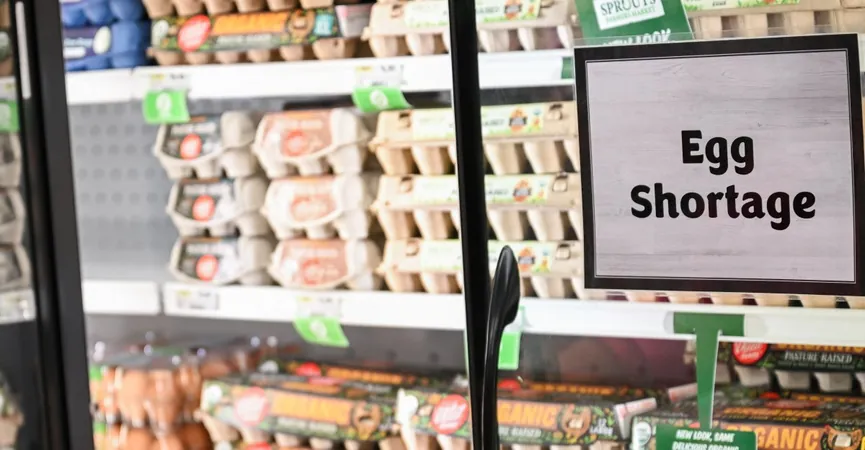
The Soaring Cost of Eggs: Is the Government Doing Enough to Tackle Bird Flu?
2025-01-26
Author: Chun
The Soaring Cost of Eggs: Is the Government Doing Enough to Tackle Bird Flu?
Egg prices in the U.S. are surging again, with the average cost of a dozen eggs climbing above $4—the stark contrast to around $2.50 just a year ago. This drastic increase can be attributed to a resurgence of the H5N1 bird flu virus, which has already led to the culling of nearly 13 million birds in the last month alone.
The outbreak has not only impacted egg prices but has also posed a serious health risk. This month, Louisiana health officials reported the first human death from bird flu in the United States since the outbreak began, underscoring the growing concern that this strain could pose risks beyond birds. Health experts had long warned that H5N1 could evolve and potentially become dangerous to humans. The unfortunate victim was over 65 and had underlying health conditions, which complicated their response to the infection.
The H5N1 strain has been circulating in U.S. poultry since February 2022. As the situation escalates, the Department of Agriculture (USDA) has reported that almost 1,000 cattle herds across 16 states are now affected, largely due to cross-species infection. While this particular death raises alarms, officials emphasize that the risk to the general public remains very low at present. The virus has not been shown to transmit easily between humans.
Despite the gravity of the situation, many are questioning whether the government's response is sufficient. Agencies like the Centers for Disease Control and Prevention (CDC), USDA, and Food and Drug Administration (FDA) are involved in monitoring cases. The USDA has established a surveillance program that traps and tests wild birds for bird flu. Infected flocks can be reported by farmers, but underreporting is a significant issue—many farmers are hesitant to engage with government officials due to distrust.
When infections are confirmed, the USDA swiftly kicks into gear, conducting culls through methods that raise ethical concerns. However, its reach is limited, and skepticism among farmers means many infections may go unreported. Critics have also pointed out that the USDA's strategies appear overly focused on maintaining industry profits rather than expanding vaccination efforts.
More troubling is the realization that while there have been innovative approaches, such as funding vaccine research and specific testing protocols for dairy products, concrete action plans remain elusive. Public health experts argue that the failure to implement vaccination for poultry—or at least encourage it—could have dire consequences if the virus mutates to a more transmissible form.
Looking ahead, the USDA predicts that egg prices will remain high through early 2025. For consumers, the FDA assures that commercially available poultry products, including eggs and milk, are safe because they are rigorously tested for pathogens. However, raw milk and dairy products from unregulated sources remain risky. Cooking animal products properly is the best way to avoid any potential contamination.
While currently no widespread bird flu vaccine exists for humans, the CDC is exploring possibilities for future vaccine development. Experts suggest that if a more deadly mutation were to occur, this could change the necessity for immediate vaccination significantly.
The looming question remains: Could bird flu be behind the next pandemic? Given the absence of human-to-human transmission so far, the immediate danger may be limited. Yet, with every passing day that the virus circulates among birds—and potentially adapts—the risk might escalate, demanding urgent governmental and public health interventions.
In the meantime, consumers are left to navigate an uncertain market, grappling with the increased cost of living due to skyrocketing egg prices while hoping that decisive action from health officials will prevent the risk of a future pandemic.




 Brasil (PT)
Brasil (PT)
 Canada (EN)
Canada (EN)
 Chile (ES)
Chile (ES)
 Česko (CS)
Česko (CS)
 대한민국 (KO)
대한민국 (KO)
 España (ES)
España (ES)
 France (FR)
France (FR)
 Hong Kong (EN)
Hong Kong (EN)
 Italia (IT)
Italia (IT)
 日本 (JA)
日本 (JA)
 Magyarország (HU)
Magyarország (HU)
 Norge (NO)
Norge (NO)
 Polska (PL)
Polska (PL)
 Schweiz (DE)
Schweiz (DE)
 Singapore (EN)
Singapore (EN)
 Sverige (SV)
Sverige (SV)
 Suomi (FI)
Suomi (FI)
 Türkiye (TR)
Türkiye (TR)